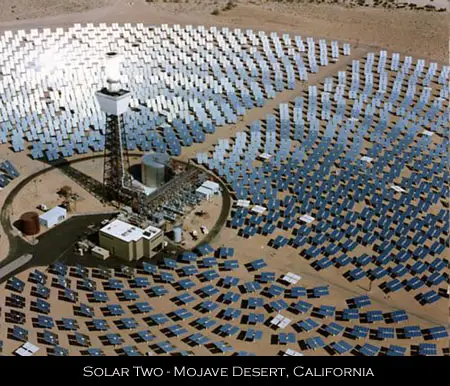Solar central power towers generate electric power from sunlight by focusing concentrated solar radiation on a tower-mounted heat exchanger (receiver). The system uses hundreds to thousands of sun-tracking mirrors called heliostats to reflect the incident sunlight onto the receiver. These plants are best suited for utility-scale applications in the 30- to 400-MWe ranges. In a molten-salt solar power tower, liquid salt at 290°C (554°F) is pumped from a “cold” storage tank through the receiver where it is heated to 565°C (1,049°F) and then on to a “hot” tank for storage. When power is needed from the plant, hot salt is pumped to a steam generating system that produces superheated steam for a conventional Rankine-cycle turbine/generator system. From the steam generator, the salt is returned to the cold tank where it is stored and eventually reheated in the receiver.

 Solar Two represents a new generation of solar central power towers, capable of producing clean, cost-effective, dispatchable electric power on a very large scale, without harmful pollutants or carbon emissions. Solar Two has also been successful in fostering commercial interest in power towers. Two of the project’s key industry partners, the Boeing Company and Bechtel Corporation, are currently pursuing commercial solar power tower plant opportunities in Spain. Solar energy premiums and other incentives under review in Spain create an attractive market opportunity, providing the economic incentives needed to mitigate the initial high cost and risk of commercializing a new technology. The proposed Spanish project, “Solar Tres,” would use all the proven molten-salt technology of Solar Two, scaled up by a factor of three.
Solar Two represents a new generation of solar central power towers, capable of producing clean, cost-effective, dispatchable electric power on a very large scale, without harmful pollutants or carbon emissions. Solar Two has also been successful in fostering commercial interest in power towers. Two of the project’s key industry partners, the Boeing Company and Bechtel Corporation, are currently pursuing commercial solar power tower plant opportunities in Spain. Solar energy premiums and other incentives under review in Spain create an attractive market opportunity, providing the economic incentives needed to mitigate the initial high cost and risk of commercializing a new technology. The proposed Spanish project, “Solar Tres,” would use all the proven molten-salt technology of Solar Two, scaled up by a factor of three.
Solar Tres consists of a 260,000 m2 solar field, from 2750 heliostats situated in concentric rings around a 120 metre high central tower. The heliostats concentrate the solar radiation on a receiver at the top of the tower. Molten salts are pumped from a ‘cold’ tank, at 290ºC, through the tower receiver, which heats the fluid to around 600ºC.Part of the molten fluid is then pumped to a heat transfer unit to create super-heated steam. The rest is pumped to a hot tank where it is stored and subsequently released to generate steam when the sun does not shine. Storage enables the plant to generate higher earnings not only from increased production but also from more predictable production. Predictability facilitates accurate forecasts on the electricity market and so helps avoid penalties for imbalances between daily-programmed production and actual production.
The Solar Tres, 15 MW solar central power tower, will be finished in 2007, at a cost of Euro 53 million. This size plant is still too small to be commercially viable, but is a solid stepping stone to proofing Solar Towers and we can expect to see much larger units in the years ahead.
